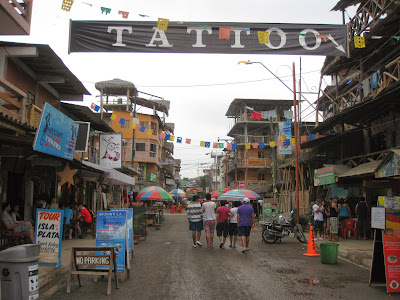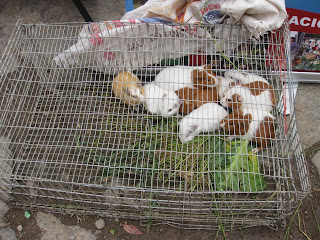 |
| Along the Avenue of the Volcanoes. |
Sometimes, here and there, I could catch glimpses of the peaks -- Cotopaxi, near Quito, at 19,347 ft; Tungurahua, towering over the resort town of Baños, at 16,500; and the highest of them all, sacred Chimborazo, at 20,702. As well as others.
Tungurahua was giving off a steady plume of ash, while glowing red at the tip at night as if the mountain itself was perpetually toking on a cigarette. Almost all of them were snow-capped, with symmetrical cone-shapes, like helpful pyramids marking the way along the High Andes.
For days the peaks had been playing peek-a-boo with me through swirling clouds and rain showers -- maddening for someone trying to take decent pictures.
Disappointed, I happened upon a religious pamphlet at a road station, with a definition of the word pilgrimage:
"...a journey, especially a long and arduous one, made to some sacred place as an act of religious devotion."
Disappointed, I happened upon a religious pamphlet at a road station, with a definition of the word pilgrimage:
"...a journey, especially a long and arduous one, made to some sacred place as an act of religious devotion."
 |
| Fellow travelers on the bus. |
Quite honestly, if I had just wanted Panama hats I could have gotten them in the country of Panama or back in Cuenca. No problem. And for less money than elsewhere because so many of them are made there.
As it turned out, I didn't just want Panama hats -- I wanted their history, their roots, their core. Actually I was on my own pilgrimage, of sorts, which is why I descended those mountains and endured that god-awful stretch of Ecuadorian coastline.
 |
| A street in Montañita -- tourist trap extraordinario |
Indeed, the beach towns that I visited were some of the biggest holes that I've ever landed in -- Montañita, Puerto López, etc. I didn't leave them as much as flee them ASAP. I can't say that I wasn't told -- other trekkers had warned me. But Montecristi, the veritable Mecca of Panamas, was but a few miles inland, practically en route, so I thought that I'd breathe a little salt air first.
On these trips, I've learned, you have to go with it...go with the flow. And the flow was spurring me away from the squalor and grayness of the coast, toward the interior, where the sun finally shone through.
 | |||
| Your humble correspondent -- under the big sombrero at last. |
What interested me there as much as anything were the straw cutters. Even now, in the 21st Century, they're still guided by the moon. For five days in
every lunar cycle, after the moon reaches its waning quarter -- then and only then -- do they machete down toquilla, the
ten-foot-tall, palmlike plant from which the
hat is woven.
However, it's more than mythology: The straw holds less moisture then and thus is lighter, easier to cut, and more pliable to weave. It's something that has been learned through the centuries. It's what gives Panamas, the genuine articles, that light-as-a-feather feel, that cock-of-the-walk attitude, that combination of style and practicality which virtually oozes of the tropics when you see one.
WOW! I recoiled, now this is what they do when you get to the source of something: myths, lore, trivia, facts to amaze, and, of course, making them. After drying and sorting and aging, the palm is taken to places such as this...
 |
| Glenda Pachay in front of her family's home/hat shop. |
Regular households, really, which are scattered throughout Montecristi. These are where the real work is done here, where the superfinos are made. For some models, the artisans can take two months to make and the weave is so tight you can tip them upside down and they'll hold water! In fact, locals used to use them to haul water.
Pop one of these babies on and look in the mirror -- you can see why they've become a fashion statement. Not only does your look change but your disposition as well. I angled my head higher, acquired a little strut in my walk.
Pop one of these babies on and look in the mirror -- you can see why they've become a fashion statement. Not only does your look change but your disposition as well. I angled my head higher, acquired a little strut in my walk.
 |
| Flerida Pachay Anchunida at work inside. |
For my purposes anyhow, Flerida Pachay about did it. Spending time with this master hat maker and her daughter Glenda was both informative and a true delight. Plus I came away with a sense of closure. The mission was now completado.
Their household, and dozens of others in Monetcristi and nearby, are where the tradition of Panamas began, and where it continues to this day. I had seen the process from top to bottom, and had even trod the dirt from whence they are grown.
Their household, and dozens of others in Monetcristi and nearby, are where the tradition of Panamas began, and where it continues to this day. I had seen the process from top to bottom, and had even trod the dirt from whence they are grown.
Through this last month, seeking them out had been a true adventure, travel at its best. Like all such endeavors, it had its ups and its downs. But boy, what a pay-off.
Now all that was left, I decided, was to buy a few.
 |
| Back home with three different styles. |
Finally, a travel thought: Ecuador uses United States dollars as the national currency, which cuts down on some of the stress of traveling as you don't have to change money when you arrive, you aren't charged extra fees for credit card transactions, etc. Which makes it nice and simple.
Un saludo a Ecuador for that!
THE END


















